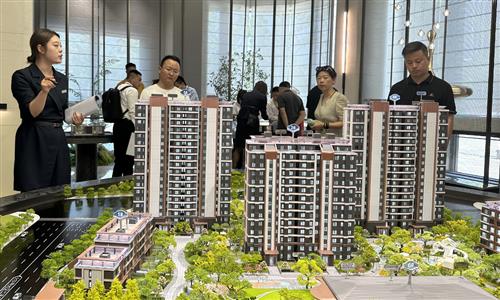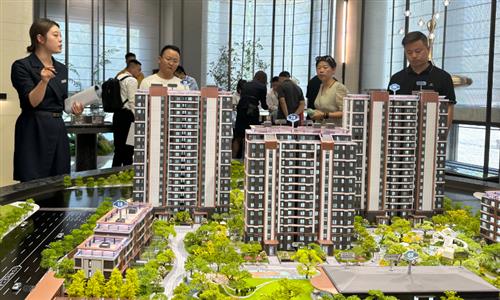

Real estate. Photo:Xinhua
Despite the overall decline in population since 2022, there remains significant potential for growth in demand in China's real estate sector due to the rising urban population and improving living standards. Mid-term real estate demand will still be maintained at a healthy level, and there will not be a "demand cliff." As new quality productive forces will increasingly serve as another major engine of economic growth, the Chinese real estate sector will enter a new stage of high-quality development.
In the middle- and long- term, China still has substantial demand for housing along with the continuous urbanization process. China's urbanization rate has reached 66.16 percent by 2023, which is still about 15 percentage points lower compared with countries like the US, Japan, and South Korea. The ongoing urbanization process will continue to bring in new urban populations, leading to increased demand for housing.
China has great potential for growth in housing demand. Compared with major developed economies, the per capita housing usage area in Chinese urban areas remains relatively low, reflecting room for significant growth. According to international experience, per capita housing area will increase, but the rate of increase will slow down. It is estimated that from 2020 to 2030, the compound annual growth rate of per capita housing area in Chinese urban areas will be between 1 and 2 percent, still representing a considerable demand for housing improvement.
Against the overall backdrop of continuous releasing of demand for better housing, second-hand homes will be frequently put up for sale in the market. From a national perspective, in 2023, the proportion of second-hand house transactions to the total number of transactions of houses is close to 40 percent, an increase of about 10 percentage points compared with the same period in 2022. This indicates a change in the housing transaction structure, with second-hand transactions replacing what were previously new home transactions.
The increase in the number of second-hand homes put up for sale is driven by the accelerated release of improving housing demand. Most second-hand house owners who list their properties for sale are actually potential home buyers. In early September 2023, the implementation of rules easing restrictions on mortgages for second homes, allowing them to be treated the same as a first mortgage as long as the buyer has paid off the first loan, has led to a surge in the number of houses put up for sales.
Industrialization and urbanization have been important drivers of economic growth in China in the past. With the slowing growth of urban population, the main engines of economic growth in the medium- to long-term in China will be technological innovation and consumer spending.
As the burden of housing affordability for residents gradually decreases in the medium- to long-term, the potential for consumer spending will be unleashed to a greater extent. Based on the pursuit of a better life by a growing middle class, important consumer sectors such as tourism, home decoration, smart cars, culture and entertainment, fast-moving consumer goods, elderly care, and healthcare will see further growth in scale and quality improvement.
In addition, given the country's scale, China can quickly and widely apply technological innovation, and with capital from the original infrastructure investment sector flowing into the field of technological innovation, it will accelerate the pace of technological innovation.
In the traditional economic growth model, local efforts and investments in economic development are mainly rewarded through land appreciation. This model can form a closed loop of development, but it also brings about economic growth problems such as high housing pressure, heavy reliance on infrastructure investment, and a large amount of ineffective and inefficient investments. In the future, the demand for new land will weaken, and land finance will gradually fade out, breaking the closed loop of traditional development models.
The economy will shift from investment-driven to innovation-driven. Compared with urban land management, investment efficiency and return on investment in technological innovation are higher, economic volatility is lower, human capital can be fully utilized, and residents' living standards can improve more quickly. A high-quality labor force, good infrastructure, and a vast market will support the economy's shift toward innovation-driven growth.
As the economy gradually reduces its dependence on real estate, economic growth will have a broader outlook. Breaking away from the paradigm of high investment, high housing prices, and high debt, meeting diversified housing needs, the real estate industry will enter a new stage of high-quality development.
The author is a research fellow at National Academy of Economics Strategy, Chinese Academy of Social Sciences. bizopinion@globaltimes.com.cn



